|
P-39 Airacobras in VVS – General characteristics
By Michal Sekula
|
March 2, 2014
Soviet Cobras on the South
This article is the summary of the discussion about Victory marks on Pokryshkin's
P-39 "100" I started at http://sovietwarplanes.com/board/index.php?topic=1367.0.
This part is focusing on the some technical aspects and painting of P-39s used
by VVS on the South. It would not be possible without invaluable help of forum
members, mainly KL and Massimo Tessitori.
There is an interesting article "Early Versions of Airacobra Aircraft in
Soviet Aviation" by Valeriy Romanenko at
http://lend-lease.airforce.ru/english/articles/romanenko/p-39/. I picked
up info about L-L aircraft delivery/acceptance process:
"…The crates containing aircraft components were opened, inventoried,
and checked for damage in the presence of the representative of the Import Directorate.
Special attention was given to the "newness" of the aircraft (had this
aircraft been subjected to previous use and repair).
P-39D-2 Airacobras (Bell Model-14A) arrived in the USSR exclusively by the "southern"
route, through Iran. In the summer of 1942, the Soviet VVS created an assembly
airfield at Abadan (Iran) and positioned there approximately 300 Soviet engineers
and workers...
At Adzhi-Kabul the delivered aircraft were turned over to the 25th ZAP, which
was the "southern" training center analogous to the 22d ZAP …
"
Chapters
- Propeller
- P-39 weapons
- P-39 painting
- Types of red stars national insignias
- Blue circles or not?
- Red stars on the upper wings or not?
- Positions of national insignias.
- Paints used for repainting original USAAF national insignias.
- Red tail tip?
- Personal Planes?
- Fuselage reinforcement (Update Sep 12, 2019)
PROPELLER
| Type |
Engine |
Propeller |
| P-39D |
V-1710-35 |
Curtiss-Electric |
| P-39D-2 |
V-1710-63 |
Curtiss-Electric |
| P-39F |
V-1710-35 |
Aeroproducts |
| P-39K |
V-1710-63 |
Aeroproducts |
| P-39L |
V-1710-63 |
Curtiss-Electric |
| P-39M |
V-1710-83 |
Curtiss-Electric |
| P-39N |
V-1710-85 |
Aeroproducts |
| P-39Q |
V-1710-85 |
Aeroproducts |
1. Curtiss Electrics Propellers:
Propeller blades can be black or grey and with or without yellow tips.
Yellow stencils are on the black blades, while black stencils are on the silver-grey
blades.
Stencils are wider and shorter and positioned closer to the propeller blade
root.
(Note the old type of the P-39 front gear)
|
 |
2. Aeroproducts propellers:
Propeller blades can be black or grey and with or without yellow tips.
Yellow stencils are on the black blades, while black stencils are on the silver-grey
blades.
Stencils are narrower and longer and positioned further from blade root.
(Note the new type of the P-39 front gear) |
 |
P-39 WEAPONS
There is often mentioned that Soviets removed the wing machine guns to improve
roll rate by reducing rotational inertia. However, it seems that “removing
wing guns” was mainly about gun pods.
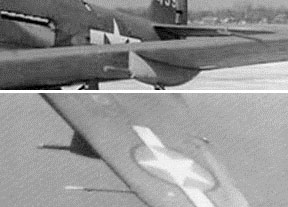
|
The USAF P-39 underwing pods with 12.7 mm machine guns are
well visible here, but are rarely seen in Soviet service.
|
Following two images show wing mounted guns (not in underwing
pods) still in place:
 |
Left:
Rechkalov’s P-39N-0 s/n 42-8747 from 1944/45
(note clearly visible USAAF background under the star).
|
 |
Pokryshkin’s P-39N-0 „100“ S/N: 42-9004 from
the summer 1943.
Wing guns are installed, at least at the date of well known
photography. |
Technical description and drawings in Romanenkov's book "Aerokobri vstupayut
v boi"are based on original Technical manuals from 1943. This book confirms
that 16 giap initially had P-39D-2s armed with 20mm cannon and P-39Ks
and P-39Ls armed with 37mm cannon.
37mm T9 cannon
 |
The Airacobra was designed around the 37mm T9 cannon of the weight 213 lb
(97 kg) and length 89.5 in (2,27 m). The propeller was driven via a 10-foot-long
(3.0 m) drive shaft running through a tunnel in the cockpit floor and was connected
to a gearbox in the nose of the fuselage which, in turn, drove propeller via
a short central shaft. Cannon fired through the short central propeller shaft.
Original M6 magazine 37 m/m M4 (endless belt type) Capacity 30 rounds symmetrically
mounted (used on plane P-39) |
 |
Airacobras delivered earlier had 37mm cannon usually without protecting
cover: |
 |
Airacobras delivered latter (L, N, Q) had 37mm cannon usually protected
by cover: |
20 mm (.79 in) Hispano-Suiza HS.404
cannon

|
P-39D-1 and P-39D-2 (Bell Model 14A) were specifically
Land-Lease orders. Both were armed with more reliable 20 mm (.79 in)
M1 cannon. This was an American licence of the British Hispano designated
M-1:
• Length without muzzle brake: 2.32 m (7 ft 7 in)
• Length with muzzle brake: 2.52 m (8 ft 3 in)
• Weight without drum magazine: 43 kg (94 lb 13 oz)
• Weight (complete): 68.7 kg (151 lb 7 oz)
http://pwencycl.kgbudge.com/H/i/Hispano_20mm_gun.htm |
 |
As one can see that:
• 20mm cannon had quite complicated barrel
while 37mm cannon had very simple barrel,
• 20mm cannon was longer
(with or without muzzle brake) than 37mm cannon,
• weight of 20mm
cannon was approximately half of 37mm cannon weight, plus ammunition,
•
20mm cannon mounted more to front then 37mm cannon (to balance lower weight/center
of gravity of P-39, etc.). |
It could be said in general that if "short simple barrel"
is going through spinner it should be 37mm cannon and if "something long
with complicated barrel" is going through spinner it should be 20mm cannon.
P-39 Painting
Screen shots from the short COLOR video "featuring" P-39 in VVS I found
a on Youtube http://www.youtube.com/watch?v=HeFlN7TS3Vk

Pict 1 - nose vents on the both fuselage sides are visible - applicable from
P-39K version,
Pict 1+6 -37mm cannon without cover,
Pict 2 - big repainted (darker) area below and behind exhaust pipes,
Pict 2+3 - original US star on the right under wing repainted - see glossy area,
Pict 4+5+6 - old "balloon type" front landing gear, applicable until
P-39K. P-39L and latter had tire of thinner profile,
Pict 4+5+6 - grey propeller blades without logo and stencils - could be Aeroproducts
propeller,
Pict 5 - red star without white outline on the fuselage and without original
blue or white circle,
Pict 5+6 - external 75 gallons fuel tank under the central fuselage,
Pict 5+3 - short 5-digits serial number, something like 24??0 or 24??8 - applicable
for series from P-39K-1 (S/N: 24244) to P-39N (S/N: 24999).
 |
Another "early" P-39 with red star without white outline on the
fuselage:
- Original blue or white circle is repainted - see more rounded pentagon
than circle under the red star.
- Red star is quite glossy in comparison with Matt Olive Drab.
- Note old "balloon type" front landing gear of P-39 standing
behind.
|
Both pictures show early P-39s with "boring" camouflage of
that days (1943) - original Olive Drab + Medium Grey plus red stars without blue/white
circles. Nothing like different colorful, personalized and highly decorated P-39Qs
from 1945.
Types of red stars national insignias
USAAF introduced new insignias - White rectangle or bar was added on each side
of the blue circle with a red border surrounding the entire insignia on June
29, 1943 and updated on Aug. 14, 1943 - red border was replaced with blue one.
 |
P-39Q-1BE, S/N: 42-19447, produced sometimes on May 1943, photographed
on July 1943.
Wearing already new USAAF insignias with red outline, |
 |
P-39Q-5-BE, S/N: 42-20397, produced sometimes on August 1943, wearing new
USAAF insignias.
|
 |
This P-39Q-1-BE, S/N: 42-19483 although newer then P-39Q-1BE, S/N: 42-19447,
still wearing old USAAF insignias. |
Time period from P-39 production to arrival to 16th GIAP took several months
- approximately 1 year at the beginning, 5-6 months later. It shows that first
delivered versions P-39D and P-39K were not new planes.
P-39s delivered to VVS via L-L program had basically two types of national marking:
1.)"Buffalo" version - red stars in white circles (either new one or
repainted before-or-after-July-1943-USAAF-marking)
2.)original USAAF national marking - white star in blue circles with or without
with white bar on sides with red/blue outline
Depending where, when and how repainting was performed in Soviet Union there
were several possibilities of national insignias used on P-39 in VVS on the South:
1.)Red stars in white circles
(well known Sukhov's "50") |
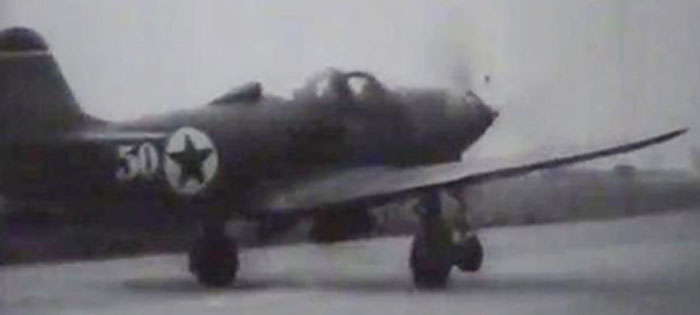 |
2.)Red stars (old black outlined version or new white/red outlined version)
in original USAAF blue circles,
(Rechkalov's P-39N-0 s/n 42-8747 ) |
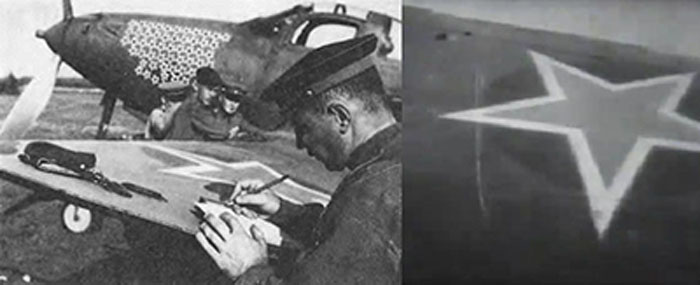
|
3.)Red stars (old black outlined version or new white/red outlined version)
in green circles.
Green circles not always regular, repainting often done in rough manner.
(Rechaklov's P-39Q-15 s/n 44-2547 ) |
 |
P-39Q-15 "26" from Hyryia wears original new USAAF insignia (e.g.
with side bars) repainted still in US to "Buffalo" style (e.g. Red
star in white circle) and latter repainted in VVS to look like 1944 and latter
standard soviet insignia.
VVS red stars with white & red outline were introduced on 3-Sep-1943
(Order NKO no.267) so they could appear on some P-39N-5 earliest if VVS technical
personnel was fast enough.
However we can find examples when even latter versions had red stars with old
black outline:
 |
P-39Q-5, S/N: 42-20136, produced sometimes on July 1943 and delivered do
VVS sometimes in Dec 1943, still wears old type black outlined red stars while
original disk is irregularly painted green. |
If examples above reflect usual approach of the VVS technicians then a lot of
late P-39s (versions Q-10,15,20...) profiles is incorrect. They should show planes
with new USAAF insignias completely repainted green. There is no reason to suppose
that Soviet technicians would overpaint green only white side bars while kept
blue circles under red stars. No photo evidence proves such approach. Therefore
profiles of late VVS Cobras should not show old USAAF insignias (blue
circles) on P-39s produced after July/August 1943.
Blue circles or not? Almost Hamlet's question.
There was a big airplane assembling factory in Abadan built by Douglas in line
with USAF order.
Red stars painted in Abadan were in line with rules, e.g. with the thin (1cm)
black outline. But blue circles were repainted rather sloppy, often with British
or Russian paints, which did not match original US Olive Drab and Neutral Grey…
So often blue circles were kept, red stars with black outline over them. The
planes were flown to 25ZAP in Adji-Kabul after repainting. But sometimes planes
were flown from Abadan to Adji-Kabul with original USAF stars. In such cases
the final look of the stars and circles strongly depended on the taste of the
25ZAP technical staff… (V. Roman, Airacobras over Kuban)
Following images, although showing different planes from the different fronts,
could serve as good examples of “circles were repainted rather sloppy,
often with British or Russian paints, which did not match original US Olive Drab
and Neutral Grey”.
1.) Original US repainting to give P-39 look of the new L-L
plane
http://lend-lease.airforce.ru/photogallery/p-39_fairbanks/ |


|
2.) Soviet repainting
(http://lend-lease.airforce.ru/english/articles/sheppard/p39/)
Note: upper wing star overpainted
|



|
another example of Soviet repainting of blue circles P-39 from Finland
Note: Upper wing star kept. |


|
Repainting "rather sloppy" was not limited only to P-39s from 25ZAP:
However, low contrast between OD background and circle on the b&w photos
does not necessarily mean repainting.


|
Here are photos showing low contrast also on the original US insignia |
Red stars on the upper wings or not? Positions of national
insignias.
Scenario 1 – P-39s coming to SU with “Bell” transport
marking – red stars in white circles:
| - red stars in white circles painted on the new P-39 on both under
wings and fuselage, but no upper wings: |
 |
| - red stars in white circles carefully painted over original USAF
national marking on left & right underwings and fuselage while and USAF
nat. marking on upperwings overpainted by green. |
 |
Even existing USAAF marking were painted out. So at least during some time
period Bell or someone else in US paid attention to carefully painted out standard
USAAF stars.
Scenario 2 – standard USAF national marking overpainted either
in USA or in Soviet Union:
2.1. White stars in blue circles repainted red while
blue circles overpainted and additional red star painted on right upper
wing and left underwing.
Overpainting was done with paints available at that moment – if in
Abadan then probably most often with OD delivered together with the planes.
If not available, then (either British or) Russian paints. |
 |
| If already in individual IAP/GIAP then most probably with available
Russian paints: |
 |
| 2.2. White stars in blue circles repainted red while
blue circles kept and additional red star painted
on right upperwing and left underwing. |
 |
This video
http://www.youtube.com/watch?v=arWU-lzYjh0 shows following interesting
moments:
34:52 P-39 starts its long journey via “Northern path” through
Alaska to SU.
Soviet red stars (older type with black outline) are already painted on
the both underwings. |
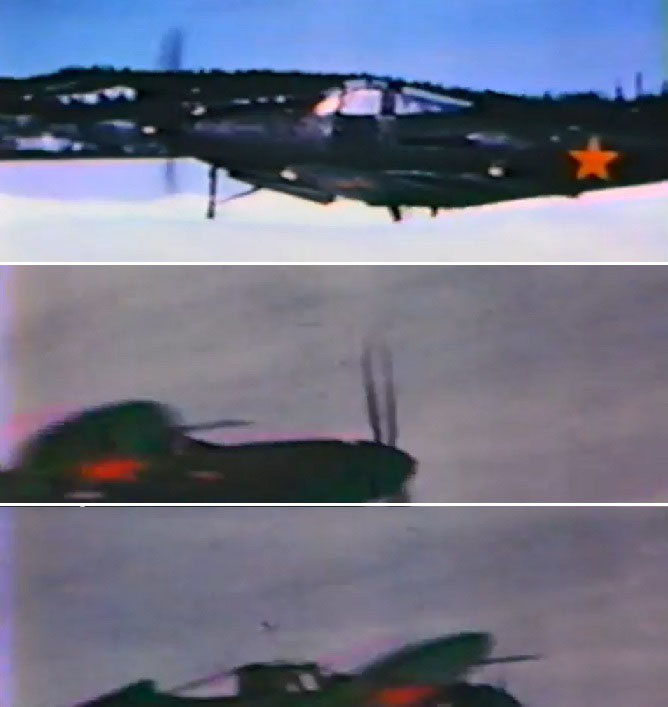 |
32:04 Original old type USAF white star in blue circle is
being repainted to the VVS red star with black outline:
Note rough painting over the original blue circle. |
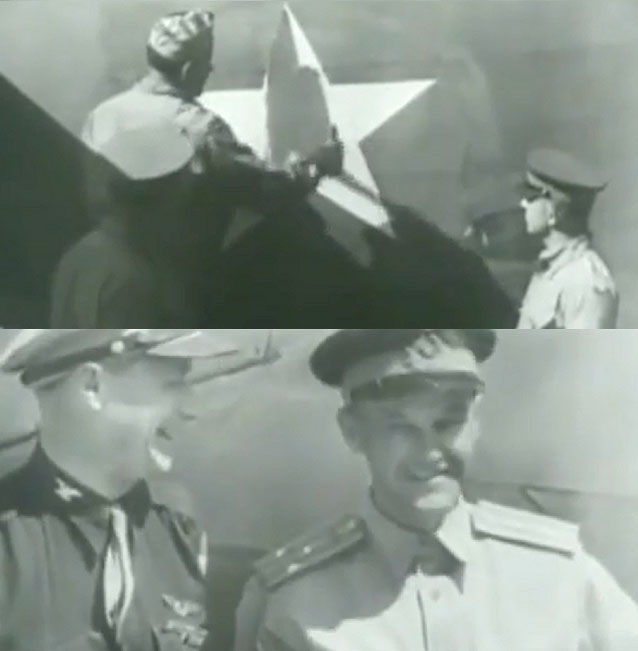 |
|
33:36 wooden crates with disassembled planes delivered via “Southern
path” are shown.
Latter, P-39s are assembled and soviet red stars (latter version with white
outline) are painted over original latter USAF marking.
White bar and blue circle & outline, still visible, wait for overpainting
with green. |

|
The question is whether those dark circles are really original blue circles
or fresh careful green overpaintings. Soviet "field" overpaintings
are known more by its usually rough way.
Although VVS is military organization and everything is/should be done by order
(defining what, when and how has to be done), photos show a wide variability
in such orders implementation.
Paints used for repainting original USAAF national
insignias
Here are some interesting points from scalemodels.ru at http://scalemodels.ru/modules/forum/viewtopic_t_17216.html:
Why there is such confidence that USAF marking on P-39s were repainted in
Soviet Union? On Airforce.ru there is a photo of machine, which did not leave
United States and there is clearly seen that USAF marking was repainted several
times, according to the several times changed USAF rules
http://lend-lease.airforce.ru/photogallery/p-39_fairbanks/index.htm
In my opinion, discussions about Soviet national marking painted in the VVS units
with "what found on the shelf" are the same legends as "tractor
green". This is true only for British Hurricanes and Hampdens in the North,
delivered to SU by completely other ways, not within the lend-lease. And then,
together with the planes were delivered such things like ZIP, which includes
also a "native" paint.
vs.
Paints were not included in ZIP and they painted with what they had.
There are following options when trying to find standard VVS paint colors
rather than some custom mix from anything on hand:
1.) VVS paint AMT-4 green, developed (from green tonality
point of view) from Army 4BO. AMT-x were nitrocellulose lacquers for mixed
construction planes, they could be utilized on metal, wood and fabric. They
were introduced in mid 1941. AMT-x paints were used on metal planes only if
surfaces were primed firstly. Primed means yellow/brown ALG-1 over metal surface,
but this has not been seen on wrecks.
Photos show that overpainting was done on the already more-less "primed"
surface, e.g. original US primer + Olive Drab + Blue/White paint.
Unit had previously MiG-3, I-16 and Yak planes so in the spring/summer 1943
they still could have spare AMT-4 on stock together with common Army 4BO paint.
No new paints delivery would be necessary, at least at the beginning, during
hectic Kuban campaign. |
 |
| 2.)VVS paint A-24m green is oil paint for all-metal planes,
equivalent to AMT-4. A-xx-m were matt oil-based paints for all-metal planes,
introduced in 1941. They had the same pigments of the corresponding AMT series,
but the medium gave to them a more brownish-yellowish shade, visible on the
light colors. |
 |
3.)Army 4BO green paint was used for military vehicles
etc. so it could also be on hands.
Oil/alkyd paints are harder and more resistant to weathering. However, from
modeler point of view it is important that they all looked similarly or even
identically, at least when freshly painted. |
 |
4.)In the case of under wings it could be blue nitrocellulose varnish
AMT-7 blue
or its oil equivalent A-28m,
but also other green or grey paints for upper or inner surfaces. |


|
AKAN paints are the best representation of these original paints
appearance in one-to-one comparison with original without “scale effect”
or fading.
Red tail tip?
The following photos of the original US Cobras show tail tip of a slightly different
color than the rest of the tail - regardless date and region. It seems to be
a matter of light reflection:
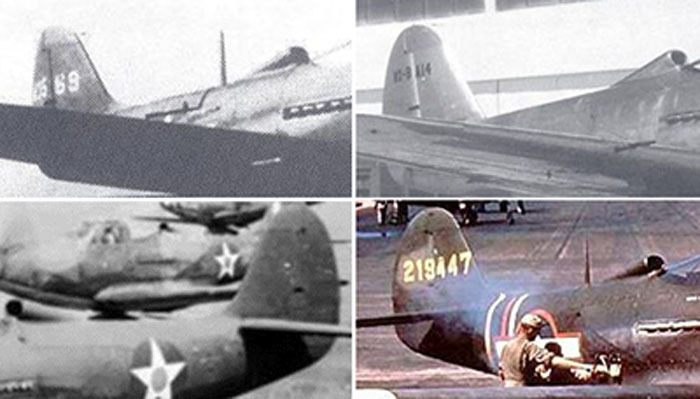
Red propeller spinner and red tail tip as 9th GvIAD divisional
symbols were introduced in 16th GIAP in autumn 1943.
The profiler Igor Zlobin wrote: “According to the info from historian
Oleg Levchenko and after one month in the archive in the city of Podolsk (CAMO)…
I deleted red tail tips on the planes from period spring-summer of 1943.”
Following photos show different Cobras from 16 GIAP.
 |
Pokryshkin in front of unknown P-39, probably just before the flight on
"his" Cobra. As usually in such cases, no number helping identify
his plane is visible (retouched?) |
 Left: Left:
Late Rechkalov's P-39 when photographed with Pokryshkin.
Right:
Klubov's P-39: |
 |
 |
Pokryshkin, B.B.Glinka (shot down on 14-Jul-1944, did not fly anymore),
Rechkalov, Klubov (died on 1-Nov-1944 in La-7 accident) and some others |
 |
Suchov's P-39 flown by Pokryshkin during "highway exercise" |
 |
:Unknown P-39 from document movie about Pokryshkin.
|
All photos of the Russian P-39s above show red tail
tip with thin white trim.
However, again there are examples when something is different.
There are missing divisional symbols on Dmitri Glinka’s plane from
100 GvIAP, which also belonged 9th GvIAD.
The plane was supposed to have the symbol on the tail and spinner, but it
had not: |
 |
Personal Planes?
Here are some notes about plane usage in VVS (info from the book Pokryshkinskiy
aviapolk - Nelakirovannye boevye chroniki (Pokryshkinsky Regiment - unvarnished
combat chronicles) by Tabachenko).
The particular plane was not strictly dedicated to the particular pilot.
Any pilot of particular IAP (GIAP) could be ordered to fly any plane from the
unit. However, each pilot made effort to fly “his” plane. But if
some better pilot or pilot without plane at that moment (e.g. damaged plane,
maintenance, etc.) had to fly, he could fly any plane ordered to him by the unit
commander.
Only person strictly related to the plane was named technician. He was responsible
“by his head” that aircraft and its armament were duly. His duty
was to prepare the plane to fly, but only commander decided who will fly the
plane.
Commander of the IAP (GIAP) could choose fly any plane from his unit, because
all planes were “his”.
Example: When Pokryshkin got 3rd HSU, he was photographed in the Rechkalov’s
plane in August 1944 after returned from flight in this Rechkalov’s plane.
Reinforcement of the rear fuselage
More and more pilots in service units were injured or even killed in stall accidents
in 1944. B. Glinka was injured in such an accident in July 1944. Similar accidents
have happened also to Klubov and Rechkalov.
From Sukhov's memoirs book Eskadrilja vedet boi (The squadron is fighting):
„Alexander Ivanovich came. Klubov's Aircraft mechanic Gregory Shevchuk
reported him:
- Fighter is deformed, the fuselage is formed like "accordion", tip
bent, torn flap holes ...
Klubov, in a wet tunic with salt stains, jumped off the plane and also surprisingly
stares at his plane:
- Wow, how how twisted is overseas technology! I did not think that the plane
will fail... said Klubov with smile.
Now it was clear whythe plane looked strangely - fuselage was deformed, antenna
gone, the transmitter has moved from its place, the hellish congestion even
cut the bolts...
End of august 1943... Rechkalov was a bit unlucky. He hit "Ju-87",
but when flying away from attacked plane, he pulled on the stick too much, very
sharply and his "Cobra" deformed."
Bell engineers went to Soviet Union to collect evidence in late fall 1943. Official
instructions regarding C.G. limits were issued in spring 1944. (http://www.airpages.ru/uk/p39_2.shtml
)
More details about P-39 stall problems and structural weakness at http://pro-samolet.ru/samolet-usa/63-istrebiteli/246-usa-istrebitel?start=12
Most important piece of info there: ?? ???????? ? ??????? ? ???? ????? "????".
?? ??????? ?????? ??????????? Q ??????????? ??????? ????????? ????? ????????
? ????? ????????? ???????? ? ???? ????????.
During testing and combat reports, the one thing the Soviets were discovering
was that the P-39 suffered a structural weakness of the rear fuselage. After
thorough testing, the Soviet LII (Flight Research Institute) and TsAGI (Central
Aero and Hydrodynamic Institute) recommended a number of improvements to be
undertaken at repair workshops from mid 1944.
These were recorded as defect and modification and twisting of rear fuselage
and skin deformation.
All Q models up to and including the Q21 had to have the following:
A) two additional skins around radio compartment hatches.
B) fuselage longeron reinforcing member
C) two supports to forward tailplane spar attachment joints
D) two plates to reinforce the port forward fuselage beam.
Items A) and C) are clearly visible on „White 23“. These skins have
been added over the red star and have covered segments of it. Whether or not
it was deemed important, the star was not repainted.
All Q series models were to have the following work undertaken to the fin.
A) reinforce fin leading edge with additional skin.
B) add third fin/fuselage attachment point.
C) reinforce the forward and rear post with additional profiles.
D) additional plates at the middle of the rudder hinge.
Items A) and B) were also visible on „White 23“. The starboard skin
of the fin was unrivetted and removed. The third attachment was added and refitted
along with the additional leading edge skin. On completion the starboard skin
to the fin was resprayed masking out the number, again visible in the photos.
Only two last P-39 versions in production - P-39Q-25 and P-39Q-30 - had tails
modified at the factory. P-39Q-25 had 4-blade propeller, very distinctive sub-type.
700 P-39Q-25 plus 400 P-39Q-30 were made. 1100 out of 4905 P-39Q made, had tails
modified by Bell.
Remaining P-39s were modified by Soviets.
Information about versions and production numbers is at http://www.airvectors.net/avp39.html#m3
P-39Q-15-BE Serial No. AAF 44-2911 „White 23“
Article about pilot of this Cobra - Lieutenant Ivan Baranovsky - is at
https://lend-lease.net/articles-en/lieutenant-ivan-baranovskys-p-39-an-airacobras-journey-to-the-eastern-front-and-back/
Buffalo Museum P-39 had its rear fuselage modified by Soviets in August 1944.
This is clearly explained at https://lend-lease.net/articles-en/bell-p39q-15be-44-2911-airacobra/
Pictures are taken from https://lend-lease.net/gallery-en/p39q-airacobra/

Reinforced rear fuselage - port (left) side:
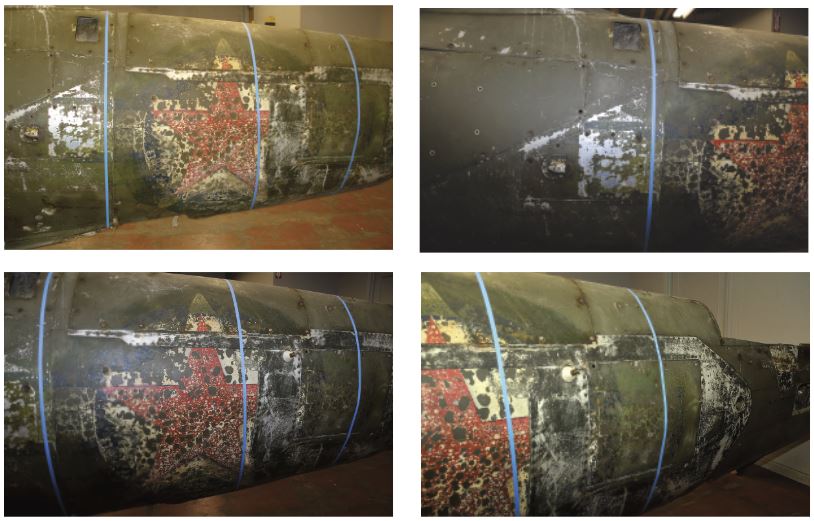
Reinforced rear fuselage - starboard (right) side:
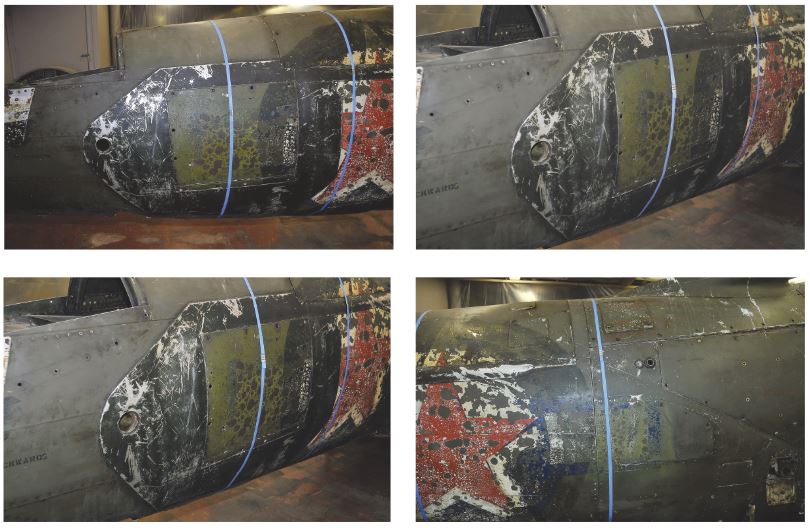
Added third fin/fuselage attachment point:

Reinforced leading edge of the vertical stabilizer:
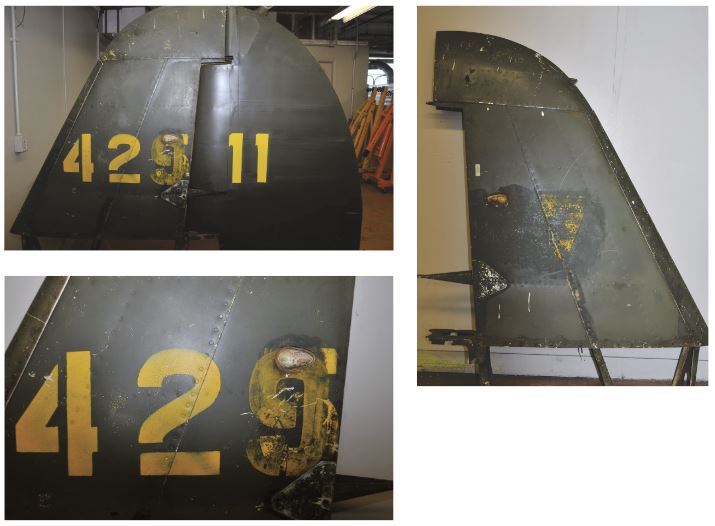
P-39Q-15-BE Serial No. AAF 44-2433
The fuselage reinforcement looks like made already in the factory.
Pictures are taken from
https://lend-lease.net/gallery-en/p-39q-airacobra/

Reinforced rear fuselage - starboard (right) side:
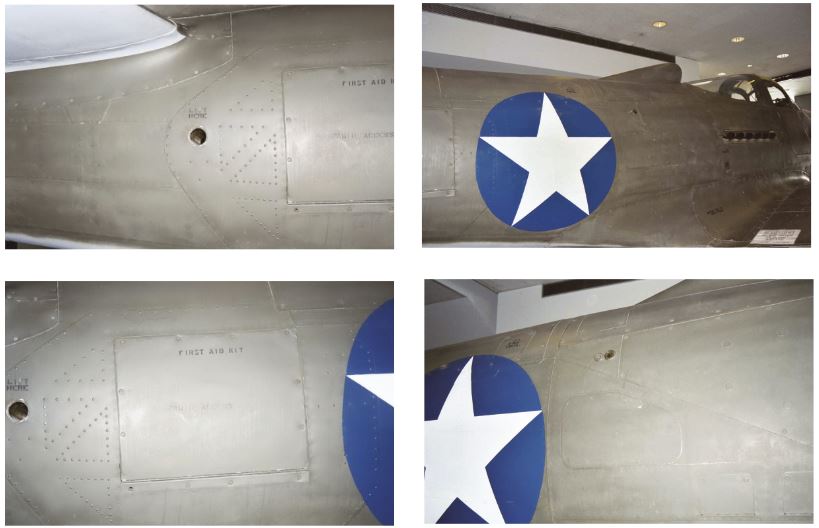
Reinforced leading edge of the vertical stabilizer:
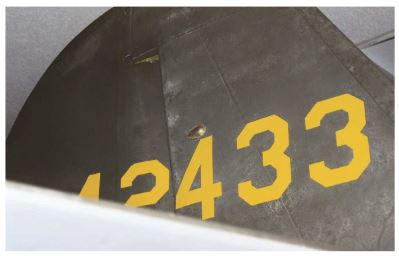
P-39Q-15-BE Serial No. AAF 44-2664 „White 26“
Late Q-15 version but still without fuselage reinforcement.
Pictures are taken from
http://scalemodels.ru/modules/photo/viewcat.php?cid=406&orderby=date%20ASC&show=12&min=12
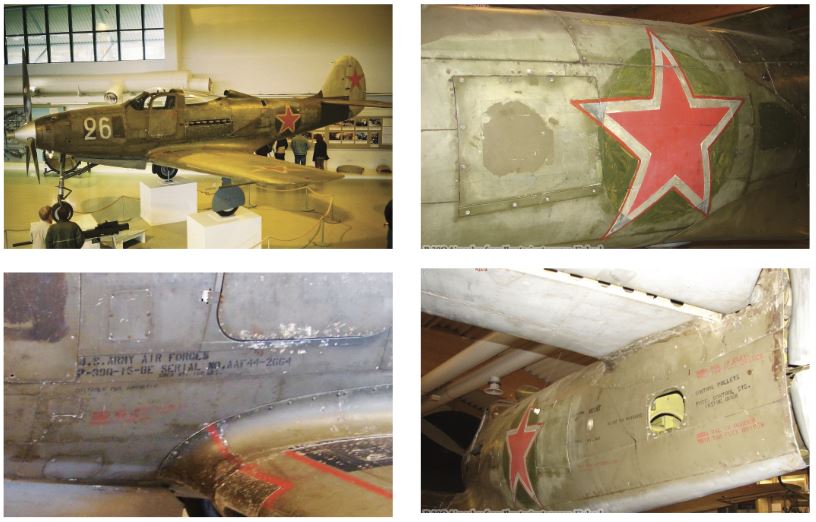
Additional examples of the reinforced rear fuselage
P-39Q from 23 giap:
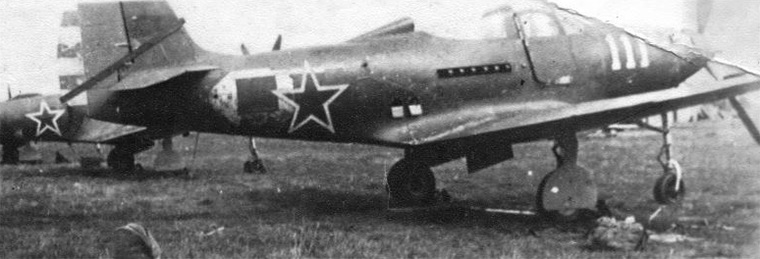
P-39Q-15 from 651 iap PVO:

P-39Q from 9 iap:
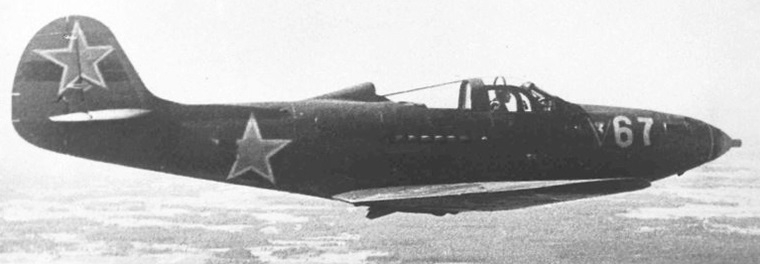
P-39Q-15 from 68 giap
Right tip and partially upper tip of the star are repainted exactly where reinforcement
covers original star.
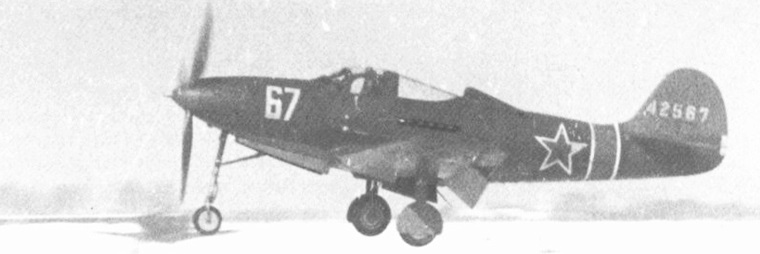
References and sources of the photos:
http://ava.org.ru/
http://massimotessitori.altervista.org/sovietwarplanes/board/index.php
and links listed directly in the text.














































 Left:
Left: 



